
Phoenix Wright: Ace Attorney – Dual Destinies Localization: The Trials and Tribulations of the Gameplay Mechanics Team
Oct 17, 2013 // Janet Hsu
An in-depth, behind the scenes look at how Phoenix Wright’s latest adventure came to be…
Mwahahahahaha! It is I, Janet Hsu – Localization Director for Phoenix Wright: Ace Attorney – Dual Destinies !
*ahem*
I mean… So, um, how is everyone doing? We are just one week (and a day) away from the release of Dual Destinies. Are you as excited as I am?
I hope you’ve all had the chance to check out the demo . If not, it’s available right now on the Nintendo eShop . It doesn’t require any previous knowledge of the series, so even if you’ve never played an Ace Attorney game before, you can jump right on in. (I, obviously, encourage you to do this.) If you’re a long-time fan who wants to remain unspoiled for the main game, the demo is a modified version of the first episode, so don’t worry; there will still be plenty of surprises for you – I promise! Or to put it another way, there are lines and situations that are ONLY in the demo, so you can’t call yourself a TRUE ACE ATTORNEY FAN unless you’ve played it! *wink*
But enough of my babbling! This week, we’ll be hearing from Ms. Ikawa and Mr. Daigo – two of our team’s game designers who worked tirelessly to make sure that your gaming experience is as fun and smooth as possible! Take it away, Ms. Ikawa!
Hi everyone! I’m Natsuki Ikawa – a game designer and member of the AA: DD Game Mechanics section (or “System Team” as we say in Japanese). Today, fellow game designer Mr. Yoriki Daigo and I will be your guides through the ups and downs of creating the new features and game mechanics you will see in Dual Destinies.
The Game Mechanics of our Dreams – The Mood Matrix
I’ll start us off with the birth of the Mood Matrix system!
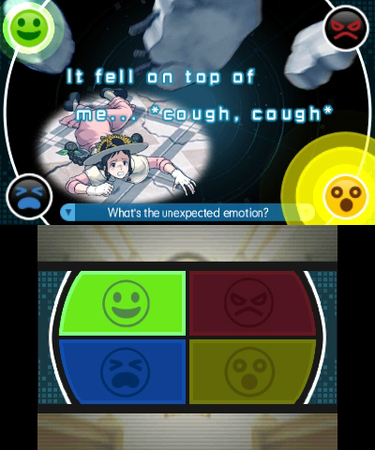
From the very, very beginning – back when we were still a skeleton team of just the core key members – Mr. Yamazaki, the scenario director kept insisting that “evidence shouldn’t be the only way to arrive at the truth – let’s find a way to add human emotions and psychological analysis to the mix!” …Which is all fine and dandy, but isn’t court all about the evidence? “How can people’s emotions reliably lead to new breaks in a case?” I wondered with anticipation. This was going to require some extremely outside-the-box ideas, I thought. Ideas like…
• Mysterious goggles that allows the player to see a witness’s true personality as a specter!”
• A super high-tech, giant computer that can analyze a witness’s brain waves and heart rate!”
Talking with other members of the team, reading a ton of books on psychology, writing up a bunch of new ideas, showing them to Mr. Yamazaki, and then showing the rejected ones to the shredder became a daily routine for me. “That’s a pretty nifty idea…” he would say, but I could tell by looking at him that, “It’s just not working for me,” is what he was really feeling. When I sat down to reflect on this, it suddenly dawned on me. “What you’re saying and what you’re feeling are in contradiction to one another, Mr. Yamazaki…” I thought to myself, and in that moment, the underlying concept behind the Mood Matrix was born.
Here is one of the sketches I drew to illustrate my initial idea.
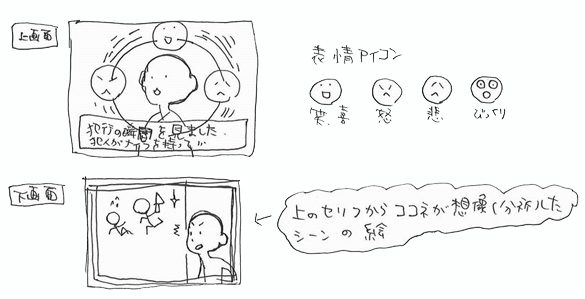
As you can see, it’s pretty different from the final version in the game, but the witness and their feelings were supposed to be shown on the upper screen while a picture or a video would be shown on the bottom
Witness statement: I saw it happen. The killer had a knife.
Explanation in the lower right: A picture depicting what happened based on Athena’s analysis of the witness’s statement (Athena’s imagination)
…You probably can’t tell because of my lack of drawing skills, but thanks to Athena’s ability, you as the player were supposed to be able to see the witness’s statement and their contradictory feelings! And then, as you resolve these contradictions, Athena’s image of what happened would be updated with a new one. After you had resolved them all, you would then put all of the fragments together to reveal a big piece of the truth!
This idea began to gather steam and after a great amount of feedback (and blood and sweat, and tears) from everyone on the team, it grew into the Mood Matrix of our dreams. I hope you’ll love it as much as I do, and that you’ll have fun interacting with the Mood Matrix as though you were Athena herself.

How Athena starts the Mood Matrix program: with a smile!
Remember, just as in real life, people can feel conflicted for a variety of reasons. I hope you will also enjoy the very human drama behind each character you question as you draw their reasons out via the Mood Matrix.
And now, I’d like to turn the mic over to Mr. Daigo!
FIGHT! The Fate of Our “Dual Destinies” Rests with Us!
As Ms. Ikawa so kindly introduced me just now, I am Yoriki Daigo, and I’m a game designer. How do you do, and nice to meet you!
Time flies, doesn’t it? We’re just one week out from the release of Phoenix Wright: Ace Attorney – Dual Destinies. Looking back on the project, I’d have to say that the things I remember most vividly are the death matches I had with the scenario director, Mr. Yamazaki…
START SCENE
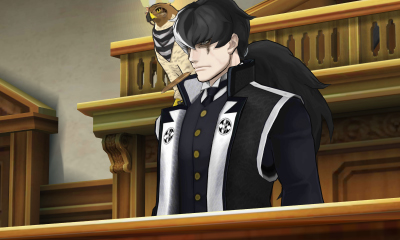
Yamazaki : Daigo-dono. As this title will be built from the ground up, I demand that the investigation sections be more visually appealing.
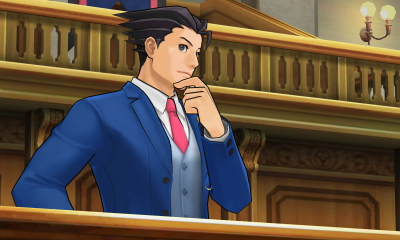
Daigo : Hmm, a complete overhaul, huh? Sounds like fun. I’ll go discuss it with the User Interface designers right away!
* time passes *…

Daigo : How’s this?
Yamazaki : Not bad. Not bad at all. Now then, about that “Move” panel. You will make it so that players can freely move to any location they wish.
Daigo : A-Any location?!
Yamazaki : Yes. Up until now, players have had to move from the Office to the Foyer, and then from the Foyer to the Room, but this time, I’d like for players to be able to jump from the Office straight to the Room if they so choose.
Daigo : B-B-But if we do that… won’t it just make it harder for the player to know where to go next?

Yamazaki : It’s YOUR job to figure out how to deal with that, is it not?
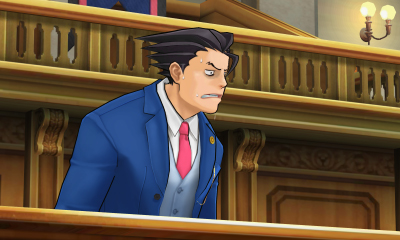
Daigo : I-I guess… (“Deal with it,” he says, as if it were that easy…)
Yamazaki : Oh, and another thing: until now, players have had no choice but to start from the very beginning of an episode if they wish to replay their favorite sections. Therefore, we should implement a system that would allow players to jump to any section they’ve already cleared.
Daigo : Oh, that WOULD be useful! Let’s do it!

Daigo : The only problem is… I’ve got too much on my plate right now to handle it on my own…

??? : Don’t forget that I’ll always be here for you, Mr. Daigo!

Daigo : It’s my dependable Game Mechanics team partner and the one who told us about the Mood Matrix above – Ms. Ikawa!
Ikawa : Thanks for the extremely long-winded introduction… *ahem* Anyway! I’m here to help you. How’s this? I be this will leave even Mr. Yamazaki speechless!
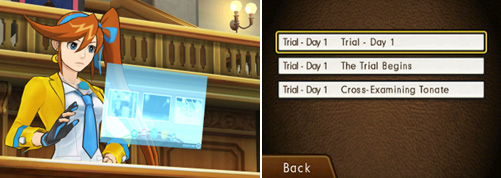
Yamazaki : Very nice! And additional panels for each episode will appear as the player progresses through the game?
Ikawa: Yes, of course!
Yamazaki : Let’s see… I’d also like to bring Perceive back, and for the Mood Matrix, I’d like it to have two modes – a normal mode and an emotionally overwhelmed mode. And while we’re at it, let’s make it so that players can investigate crime scenes in full 3D… just because we can.
Daigo : Um… Don’t get me wrong – these are all great ideas – but please tell me you’re not thinking of adding even MORE features…
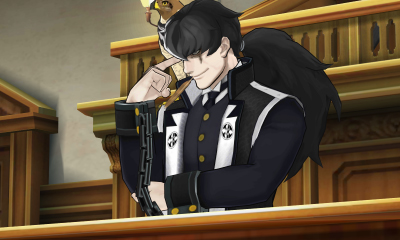
Yamazaki : Of course I am. In fact, here’s one I was thinking of just now: a game mechanic that would allow players to review the major facts of a case and draw a new conclusion. We’ll call it “Revisualization”!

Daigo : Nooooooooooooo!
Ikawa : Eeeeeeeeeeeeek!

Yamazaki : …Hmph. Do not disappoint me.
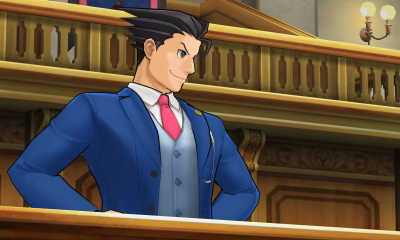
Daigo : You got it. What do you think of this “Revisualization” design document!
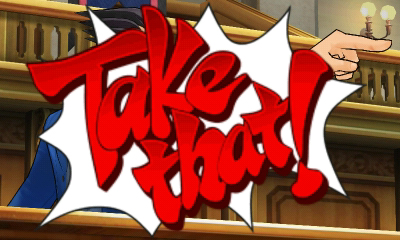
Yamazaki : What is this rubbish! “Reusing dialogue for wrong choices is forbidden”? Are you telling me that I must write a different fail message for each option?
Daigo : Yup. You’ve got your work cut out for you now, huh? But so do we, so I guess all three of us will be working overtime today, too!
THE END
…Ah, those were the days. Every day, we’d come up with some new feature to add that made the game easier to navigate or even more fun to play… and increase the amount of text Mr. Yamazaki had to write…
*This entry is a work of fiction. The characters of “Yamazaki”, “Ikawa”, and “Daigo” are in no way related to their real-life counterparts – in fact, the three of them are actually very good friends. Furthermore, all of the ideas and planning work discussed above was done by the dev team as a whole.
However…
The fact that Phoenix Wright: Ace Attorney – Dual Destinies contains some very fun and interesting new features and is now easier to navigate than ever IS NOT A WORK OF FICTION!
Thank you very much Ms. Ikawa and Mr. Daigo for that look into the Mood Matrix and the other new features that have been added to this installment of Ace Attorney series. Among the plethora of other new features that Mr. Daigo didn’t have time to mention, there are four really useful ones that I’d like to briefly share with you, along with some interesting localization issues we had along the way regarding the user interface.
Back when we released the first screenshots of Dual Destinies, one of the things that people noticed right away was the existence of these two icons down at the bottom of the touch screen:
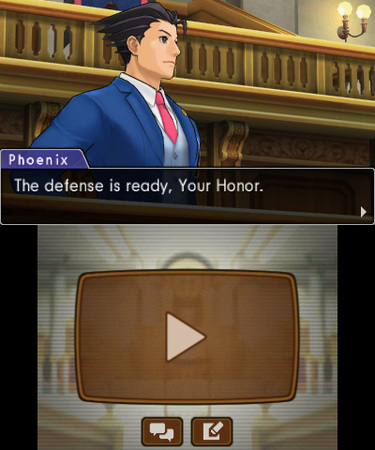
Ace Attorney fans have been hard at work honing their powers of observation through tedious pixel hunting for just this moment.
These two icons do indeed bring something new to the series that fans have been waiting for: a backlog where you can review the current conversation, and not one, but TWO save slots! No longer will you have to choose between saving at that spot where Phoenix slams the opposition and that choice bit of philosophical dialogue between your favorite characters.
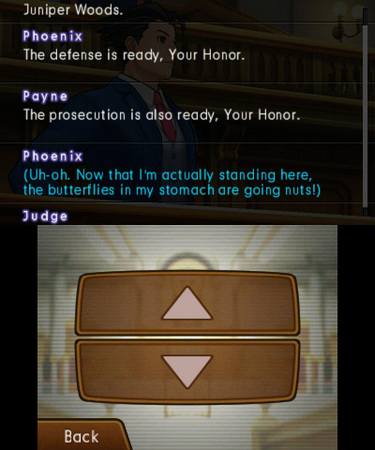
The backlog screen for all your “I skipped something by accident and need to re-read it” needs.
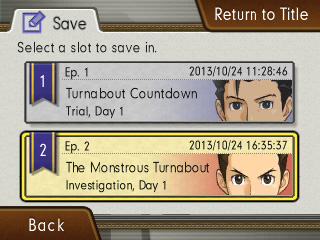
Apollo attempts to over-Wright his boss, and is demoted to Slot 2
Speaking of being in court, who hasn’t gotten stuck at a cross-examination and wished that they could turn to their assistant for advice? Well, wish granted with the new “Consultation” feature!

Thankfully, they work for you. Imagine the extra fees you’d incur if they didn’t…
Similarly, have you ever gotten lost as you were investigating, or simply forgot what you were going to do next because you were having too much fun exploring? Well, that’s what the new “Notes” function is for! (Thank you, Mr. Daigo! We knew you would come up with something!) Think of it as a check-list to help you on your way.
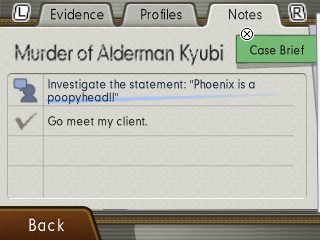
”Investigate the…” All right, who’s the joker that swapped out the real screenshot with this?!
Just by looking at the screens above, I’m sure you can already see that localization involves more than just translating the text of the story. Every button the player can touch and every bit of contextual text needs to be translated, too. Furthermore, a few of those user interface elements are graphics that need to be redrawn, and sometimes, the parameters of where the text will be displayed needs to be changed to accommodate the length of the text itself. Just to give you an idea of what I mean, here are a few side by side comparisons of just some of the UI changes that had to be made during the localization. (Those of you who’ve already played the Japanese version can look forward to finding a few more later, if you’re curious!)
â– The Save Screen
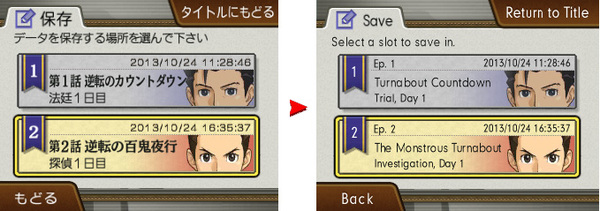
We moved some of the text around to make better use of the space on-screen because of the length of the words in English. For example, the “Ep. 1” (第1話) was moved up because the titles of the episodes themselves are longer in English. We also had to add spaces after the “Trial” and “Investigation” text strings in the localized version since you don’t need spaces between words in Japanese grammar. (In fact, it’s actually really unnatural to have spaces between words unless you have a specific reason.)
â– Consultation

The “Consulation” lettering and its fade-in/out animation had to be created and rendered for the localized version.
â– Investigation Notes

The text’s font size and positioning were adjusted so that we could display two lines instead of just one in the “Notes” tab. In addition, the name of the case had to be re-done since it is a graphic. Some layout changes were also made in the “Case Brief” section to better accommodate the length of the English text. The Japanese cultural shorthand where the numbers behind a person’s name is their age also had to be localized.
â– Main Text Window
And the most obvious one of all, the main message window on the top screen:
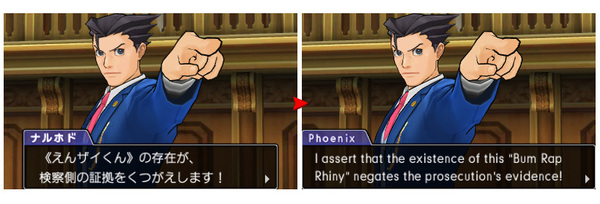
We chose a thinner, condensed font and elongated the text window so that we could fit the same amount of text in as the previous games. We went with two lines this time around not only for aesthetic reasons but because various things (including the correct answer at times) in the background or in the illustrations would be blocked by the text window if it were any taller.
As you can see, there is much more to localizing your favorite games than simply translating the story. In fact, I would go so far as to say that localizing a game’s UI is the most difficult aspect of a localization given that depending on the circumstances, there are so many more restrictions on what can be done to accommodate the target language. But the most difficult things are often the most important, and in this case, how well the UI is localized for the target language dictates what kind of text and language can be used in the game overall. (For example, will you end up with enough space for eloquent phrasing, or will you have to resort to cutting any unnecessary text just to get the objective across?)
So what kinds of restrictions do localizers and dev teams have to deal with? Well, by the very nature of the target language you’re translating to, you could be restricted by the length of the words you need to use versus the amount of real estate that’s available to you on the screen. Other times, because you physically need more letters than the Japanese to create the words you need, the game may run out of memory because each letter is worth a byte or two. (You know how you sometimes unexpectedly run out of RAM because you have too many tabs open in your browser? It’s a little like that.) And even if you could completely redesign the layout of the screen to the ideal layout, is it worth the potentially fatal bugs it might create somewhere else in the game? (Sticking with the browser analogy, have you ever opened what appeared to an interesting homepage on a new tab, switched to another one while it loads, and then frantically searched for that tab again as it assaults your ears with your least favorite song? Think of the song playing as the fatal bug and the unintended consequence of you doing something you thought would be cool.) These are just a few of the very real restrictions and questions that dev teams must face as they localize a game. The good thing is, we were able to skirt more than a few of the technical issues because we were making the localized version at almost the same time as the Japanese version, but it still took quite a bit of work for the UI designers and programmers involved.
Well, I’d better stop here for today, but I’ll be back next week with another topic before the Dual Destinies goes on sale October 24th!
Until then!
Previously in PW:AA – Dual Desinties Localization:
– Secrets of Character Design REVEALED!
– TRIVIA TIME!
– The Many Demands of an Ambitious Scenario Director!
-
Brands:Tags:
-

Loading...
Platforms:
